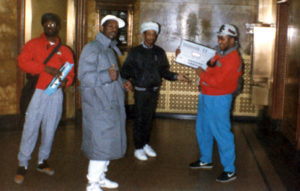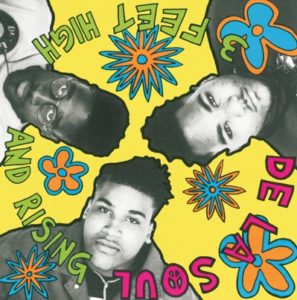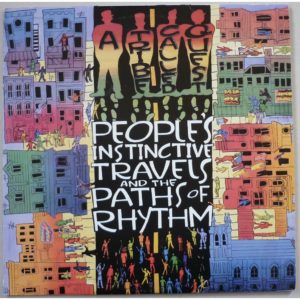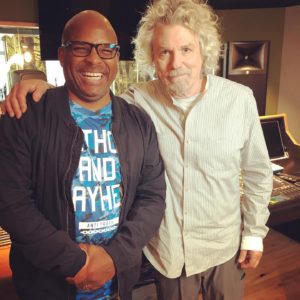
De La Soul
The fresh new sound generated by the hip-hop artists that became the Native Tongues crew (founding groups were the Jungle Brothers, De La Soul, and A Tribe Called Quest) came from something intangible. The new sound was linked to the time and place, and most importantly, the people who were able to come together in a space that had the right combination of talented artists, producers and engineers like Grammy Award-winning and multi-platinum producer, engineer, composer Bob Power who were willing to experiment with the technology that was available at the time, to help them bring their out-of-the-box musical ideas to fruition. The brightest musical minds made magic happen in Calliope and the template they created started the conscious hip-hop and jazz-rap movements.
Studios like Calliope were creative hubs during the early days of hip-hop and their lounges were vital to the development of Hip-Hop. Professor Nick Sansano who currently teaches as a colleague of Professor Bob Power at the Clive Davis Institute of Recorded Music, and produced/recorded with groups like Public Enemy, and Pete Rock at Green Street Recording Studio, during the same period likens the studio lounges of these studios “….to the salons of France…” in an interview I shared with him.

“…the pivotal role Power played in a whole host of rap classics–recording with not only Tribe but De La Soul, Black Sheep and Jungle Brothers–it would be tempting to say he was the ultimate fly on the wall for the Native Tongue collective’s greatest period of creativity. But that would be an understatement; Bob Power was the wall—as in wall of sound—providing the ear and technical knowledge to transmute a fertile stack of verses, samples and abstract ideas into a thumping sonic attack that felt like a coherent piece of art.” OkayPlayer
The Native Tongues initially included groups like the Jungle Brothers (the JB’s) whose members were Mike G (Michael Small), Afrika Baby Bam (Nathaniel Hall), and DJ Sammy B (Sammy Burwell) and the group’s manager was Kool DJ Red Alert (Mike G’s uncle). Kool DJ Red Alert was a member of Afrika Bambaataa’s Universal Zulu Nation, an organization promoting unity and cultural awareness through hip-hop. Most of the elements of what came to be known as the Native Tongues sound was a jazz influence and extensive sampling (both of which appear on the Marvin Gaye homage “What’s Going On”), ans social commentary made popular by Grandmaster Flash And The Furious Five’s “The Message,” which is sampled on the title track of the JB’s first album. It also features several verses from a young Q-Tip, who inaugurates “Black Is Black” by shouting out his newly minted group, A Tribe Called Quest. In later years Queen Latifa’s (and her British ex-pat protege Monie Love) presence in the Native tongues’ circle also added touch feminism to the social commentary that was a part of the movement.
 Ali Shaheed Muhammad and Q-Tip’s production with the technical help of Bob Power changed the course of hip-hop history by popularizing jazz-rap. Bob Power’s meticulously clean sampling of jazz organ sounded as natural in a groove as the hip-hop snare providing a stark contrast to the popular hip hop of the time. Prior to this time a few jazz-influenced cuts were created like Stetsasonic’s (of whom Prince Paul was a member) “Talkin’ All That Jazz”. But People’s Instinctive Travels’ explorations of jazz loops and breakbeats, like those in “Luck Of Lucien” (named for French rapper and Native Tongues collaborator Lucien Revolucien) and “Youthful Expression” gave rap fans a stark contrast to what has come before it. That said, Powers was not the only creative and technical influence on Q-Tip’s work in Calliope. He spent hours in the studio learning from Jungle Brothers, De La Soul, Prince Paul and Shane Faber in this studio. He also was also able to observe and record with the Queens producer Large Professor and the producer and Zulu Nation member Skeff Anselm, (who it is said, was dating Q-Tip’s sister at the time).
Ali Shaheed Muhammad and Q-Tip’s production with the technical help of Bob Power changed the course of hip-hop history by popularizing jazz-rap. Bob Power’s meticulously clean sampling of jazz organ sounded as natural in a groove as the hip-hop snare providing a stark contrast to the popular hip hop of the time. Prior to this time a few jazz-influenced cuts were created like Stetsasonic’s (of whom Prince Paul was a member) “Talkin’ All That Jazz”. But People’s Instinctive Travels’ explorations of jazz loops and breakbeats, like those in “Luck Of Lucien” (named for French rapper and Native Tongues collaborator Lucien Revolucien) and “Youthful Expression” gave rap fans a stark contrast to what has come before it. That said, Powers was not the only creative and technical influence on Q-Tip’s work in Calliope. He spent hours in the studio learning from Jungle Brothers, De La Soul, Prince Paul and Shane Faber in this studio. He also was also able to observe and record with the Queens producer Large Professor and the producer and Zulu Nation member Skeff Anselm, (who it is said, was dating Q-Tip’s sister at the time).
“Based on an entirely new blueprint both technically and philosophically, and populated with a cast of characters—many of whom would go on to become legends—Calliope was instrumental in hip-hop’s changing of the guard. In today’s hip-hop landscape, that sounds like an almost outlandish claim, especially when tweenagers can record entire albums at home on software that may even rival some of the best professional equipment of yesteryear. But Calliope was much more than a place where music was recorded, it was a place where soul was exposed. Stetsasonic, De La, Tribe, and Brand Nubian all started their careers at Calliope. Chaka Khan, Queen Latifah, Black Sheep, D-Lyte, Biz Markie, Afrika Bambaataa, 3rd Bass, Naughty by Nature, Fat Joe, and many, many more recorded there. There was something in the building that seemed to give way to genius.” Tim Brodhagen | Frank 151
Calliope Was A Creative Hub

Bob Power and David Grandison Jr at The Clive Davis Institute of Recorded Music in Brooklyn NY
The studio was started by musician-turned-engineer Chris Julian in 1984. The studios at Calliope were a nexus of hip-hop activity in the late 80s and early 90s because it was cheap and it had an engineer like Bob Powers who was willing to experiment with technology and allow the brash yet brilliant, teen artist have a space to express themselves musically. Bob worked the late-night shift when the rates were cheapest and he was open to learn and innovate with the artists that could only afford to record in the late-night studio session slots. During this period many groundbreaking and legendary albums were recorded there, along with numerous hits that reached the charts. Red Alert helped the Jungle Brothers scratch their way into the singles charts with the track “I’ll House You,” which was the first hip-house track outside of the subgenre’s native Chicago. De La Soul recorded 3 Feet High and Rising here in 1989. A Tribe Called Quest recorded People’s Instinctive Travels And The Paths Of Rhythm here in 1990. Later that same year the groundbreaking and genre-blending “World Clique” (1990) album by Dee-Lite was also engineered by Bob Power in Calliope. It showcases Bob Power’s innovative sample engineering in a more “Pop” context and it featured collaborators including Q-Tip and funk royalty; Bootsy Collins, Fred Wesley, and Maceo Parker. Other hit hip-hop albums produced at Calliope with Bob Power’s production and engineering during this period include the 3rd Bass album Derelicts Of Dialect (1991), and Black Sheep’s A Wolf In Sheep’s Clothing (1991).
…Power eventually went on to work with the cream of the ’90s soul, rap, and R&B nexus, including D’Angelo, Angie Stone, Common, The Roots and Erykah Badu, notably with the latter’s first single “On & On” and her double Grammy-winning Baduizm album. As well as his inestimable impact on hip hop and R&B, Power has also worked with such notable artists as Pat Metheny, Miles Davis, David Byrne, Me’Shell N’degéocello, and Chaka Khan.” Red bull Music Academy
Bob Powers is now a Professor at the Clive David Institute of Recorded Music in Brooklyn New York where he continues to teach young people the art of music engineering. I was able to interview him as part of the Clive Davis Institute of Recorded Music x Billboard Music Industry Essentials Course. Words by: David Grandison Jr.
